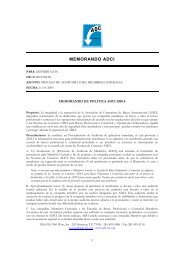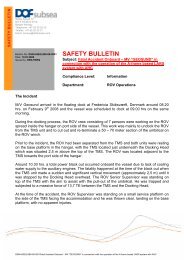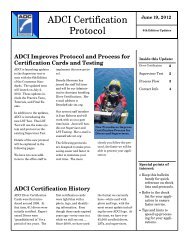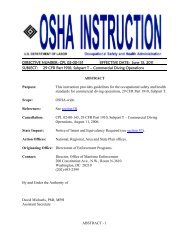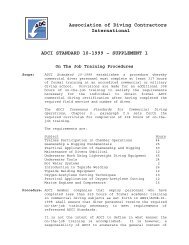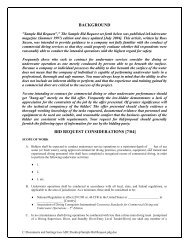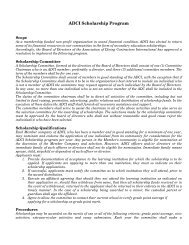SUPERLITE HELMET REMOVAL12.pdf - Association of Diving ...
SUPERLITE HELMET REMOVAL12.pdf - Association of Diving ...
SUPERLITE HELMET REMOVAL12.pdf - Association of Diving ...
Create successful ePaper yourself
Turn your PDF publications into a flip-book with our unique Google optimized e-Paper software.
ASSOCIATION OF DIVING CONTRACTORS<br />
INTERNATIONAL<br />
1
ASSOCIATION OF DIVING<br />
CONTRACTORS INTERNATIONAL<br />
A non-pr<strong>of</strong>it, industry trade association<br />
established to promote safety, communication and<br />
education throughout the commercial diving and<br />
underwater industry.<br />
2
EMERGENCY REMOVAL<br />
OF<br />
DIVING SYSTEMS INTERNATIONAL<br />
(DSI)<br />
<strong>SUPERLITE</strong><br />
DIVING <strong>HELMET</strong>S<br />
© <strong>Association</strong> <strong>of</strong> <strong>Diving</strong> Contractors International June 2000<br />
3
Commercial diving helmets are generally<br />
designed and configured to furnish a high degree<br />
<strong>of</strong> protection to the diver's head while in the<br />
water. However, by the very nature <strong>of</strong> the<br />
design considerations, these helmets can be very<br />
unstable when the wearer has suffered a neck<br />
injury or loss <strong>of</strong> motor control when in an<br />
unconscious condition.<br />
4
Standard emergency medical protocols are<br />
available outlining the first aid procedures to<br />
be undertaken in cases <strong>of</strong> suspected head or<br />
neck injuries. These same spinal injury<br />
considerations also apply to a diver who<br />
surfaces in an unconscious or non-responsive<br />
condition, or to a fully dressed diver who has<br />
slipped and fallen on deck and may be injured<br />
5
Recognizing this fact, the <strong>Association</strong> <strong>of</strong><br />
<strong>Diving</strong> Contractors International, <strong>Diving</strong><br />
Systems International, representatives <strong>of</strong> the<br />
United States Navy, commercial diving<br />
companies and representatives <strong>of</strong> commercial<br />
diving schools working together as a team<br />
have developed procedures for the removal<br />
<strong>of</strong> SuperLite helmets in a manner intended to<br />
minimize the possibility <strong>of</strong> further injury to<br />
the diver's neck.<br />
6
These procedures also furnish a removal<br />
protocol consistent with surface interval<br />
considerations related to decompression<br />
treatment <strong>of</strong> a diver in a recompression<br />
chamber. Users <strong>of</strong> these helmets should<br />
review and practice these procedures to ensure<br />
that all dive team personnel are competent in<br />
emergency removal <strong>of</strong> the helmets.<br />
7
The following procedures only address the<br />
referenced models <strong>of</strong> SuperLite helmets and<br />
were developed in cooperation with <strong>Diving</strong><br />
Systems International and may not apply to<br />
other helmet types.<br />
8
Manufacturers <strong>of</strong> specific helmets should be<br />
contacted for safe removal procedures <strong>of</strong> their<br />
helmets in suspected neck (cervical spine [cspine])<br />
injuries. Likewise, manufacturers <strong>of</strong><br />
helmets other than those identified below are<br />
encouraged to ensure that a procedure is<br />
developed and promulgated to permit safe<br />
removal in emergency circumstances and,<br />
consistent with the time lines necessary to<br />
place an injured diver in a recompression<br />
chamber.<br />
9
These procedures apply to the following<br />
helmet models:<br />
• SuperLite 17A/B<br />
• SuperLite 17C<br />
• Military Mark 21 ( SuperLite 17B/NS)<br />
• Superlite 27<br />
• Superlite 17K<br />
10
CAUTION<br />
These procedures only address the<br />
removal <strong>of</strong> the helmet while the<br />
diver is on deck.<br />
11
The intent <strong>of</strong> these procedures is not to furnish<br />
the reader with instruction in the safe methods <strong>of</strong><br />
removing the injured diver from the water or in<br />
appropriate first aid and spinal immobilization<br />
procedures. All reasonable precautions should<br />
be taken to safely remove the injured diver from<br />
the water while attempting to stabilize the head<br />
and neck under the given circumstances.<br />
12
The primary consideration should be to prevent<br />
further harm! Maintain a "neutral" position <strong>of</strong><br />
the injured diver's head and neck at all times.<br />
Maintaining a "neutral position" only implies<br />
keeping the head and neck as immobile as<br />
possible and not applying any in-line traction.<br />
13
Four preliminary recommendations are presented<br />
as applicable in recovery <strong>of</strong> the injured diver from<br />
the water and removal <strong>of</strong> the helmets:<br />
14
1. A minimum <strong>of</strong> two properly trained people is<br />
required to safely perform the removal <strong>of</strong> the<br />
helmet.<br />
2. Heavy-duty bandage scissors or "paramedic"<br />
shears (trauma shears) are recommended for safe<br />
and efficient removal <strong>of</strong> the helmet, neck dam,<br />
bail-out cylinder backpack harness, weight belt<br />
and diver's suit (wet or dry). Knives should not<br />
be used.<br />
15
3. It is a "judgement call" as to whether to cut or<br />
otherwise remove the bailout cylinder backpack,<br />
harness, weight belt, etc. before or after removing<br />
the helmet. However; indications are that if the<br />
bail-out or reserve breathing gas cylinder is left in<br />
place at the diver's back, it will help to stabilize<br />
the diver's position while the helmet is being<br />
removed, ease the effort <strong>of</strong> the rescuers and<br />
possibly mitigate the effects <strong>of</strong> vessel movement<br />
during the helmet removal procedure.<br />
16
4. The dive team member who initially holds the<br />
injured diver's helmet / head must not assume<br />
any other responsibility during the equipment<br />
removal. His/her sole responsibility MUST be to<br />
solely concentrate on maintaining the neutral<br />
position <strong>of</strong> the diver's head.<br />
17
MODEL 17A/B & MILITARY<br />
MK 21<br />
<strong>HELMET</strong> REMOVAL<br />
18
Have heavy bandage scissors or paramedic shears<br />
(trauma shears) and first aid kit at hand.<br />
19
PARAMEDIC SHEARS<br />
&<br />
FIRST AID KIT<br />
20
Address "A B C s" <strong>of</strong> first aid. AIRWAY –<br />
BREATHING – CIRCULATION. These are<br />
critical to survival and well-being!<br />
21
Maintain "recovery position" <strong>of</strong> the injured diver.<br />
Right side down. The helmet side block<br />
assembly will help to maintain the neutral<br />
position <strong>of</strong> the diver's head. This position will<br />
expose the neck clamp assembly as well as<br />
facilitate secretion removal from the mouth <strong>of</strong> an<br />
unconscious diver. It is emphasized that this<br />
lateral / side positioning is much more stable<br />
than attempting removal with the helmet in the<br />
perpendicular position (diver on his/her back).<br />
22
DIVER IN “RECOVERY” POSITION<br />
Note “bail-out” supporting back while helmet rests on side block<br />
23
Release the umbilical from the diver's harness<br />
and clear it, and any extraneous equipment and<br />
materials that may interfere with the diver's<br />
stabilization and helmet removal effort.<br />
Ascertain that there is sufficient slack in the<br />
umbilical to allow the helmet to be removed<br />
smoothly and moved out <strong>of</strong> the way after<br />
removal. Disconnect reserve gas (bailout) supply<br />
hose.<br />
24
CUT HARNESS CLEAR<br />
25
DISCONNECT BAIL-OUT WHIP<br />
26
"Crack" Steady Flow (Side Block) valve to<br />
provide additional air to diver during<br />
equipment removal procedure.<br />
Ascertain that the Nose Block Device is fully<br />
extended (outward).<br />
27
OPEN (Crack)(<br />
AIR SUPPLY VALVE<br />
28
The dive team member holding the diver's head<br />
(maintaining c-spine alignment) should place<br />
his/her right hand between the yoke/neck ring<br />
assembly and the diver's right shoulder to support<br />
the assembly. The left hand is placed on the left<br />
side <strong>of</strong> the helmet to maintain its position.<br />
29
MAINTAINING c-spine ALIGNMENT<br />
30
The second dive team member opens the neck<br />
clamp assembly and drops the clamp assembly<br />
slightly to clear the rear hinge tab from the<br />
alignment pin. If the suit is mated to the helmet<br />
cut the suit yoke rear hinge tab from the<br />
alignment pin and cut the yoke clear <strong>of</strong> the<br />
diver's neck with the shears.<br />
31
OPEN NECK CLAMP ASSEMBLY<br />
32
CLEAR REAR HINGE TAB<br />
33
Release helmet liner chin strap.<br />
34
The second dive team member then rotates the<br />
helmet forward and down to clear the oral-nasal<br />
mask, the back <strong>of</strong> the helmet rotating <strong>of</strong>f the<br />
diver's head first! The dive team member<br />
maintaining the c-spine position slips his/her<br />
right hand to the right side <strong>of</strong> the diver's head<br />
while moving his/her left hand to the left side <strong>of</strong><br />
the diver's head as the helmet is being removed.<br />
35
ROTATE <strong>HELMET</strong> FORWARD<br />
36
The helmet is then placed in front <strong>of</strong> the diver.<br />
37
MAINTAINING HEAD / c-spine<br />
ALIGNMENT<br />
38
The second dive team member (using the bandage<br />
scissors or shears) then cuts away as much as the<br />
neck dam as accessible, as close as possible to the<br />
neck clamp. This will facilitate clamp removal<br />
with minimal movement <strong>of</strong> the head / neck.<br />
39
CUTTING NECK DAM<br />
40
The second dive team member then lifts the neck<br />
clamp assembly over the diver's head while the<br />
dive team member holding the c-spine position<br />
guides the clamp and maintains the head/neck<br />
position. Move the reserve gas cylinder, weight<br />
belt and all associated equipment clear <strong>of</strong> the diver.<br />
41
LIFT NECK CLAMP ASSEMBLY<br />
42
Reposition the diver on his/her back while<br />
following standard first aid / EMS spine<br />
immobilization procedures.<br />
43
POSITION DIVER FOR<br />
IMMOBILIZATION & FIRST AID<br />
PROCEDURES<br />
44
Using shears, cut the suit neck dam and only as<br />
much <strong>of</strong> the suit as necessary to properly evaluate<br />
the diver for additional injuries. Note that the suit<br />
may provide thermal protection for the injured diver<br />
and complete removal may not be indicated.<br />
45
CUT SUIT AS NECESSARY<br />
46
MODEL<br />
27A/B, 17C & 17K<br />
<strong>HELMET</strong> REMOVAL<br />
47
NOTE: This procedure is predicated on the<br />
neck ring swing catch update kit having been<br />
installed.<br />
48
Have heavy bandage scissors or paramedic shears<br />
(trauma shears) and first aid kit at hand.<br />
49
PARAMEDIC SHEARS<br />
&<br />
FIRST AID KIT<br />
50
Address "A B C s" <strong>of</strong> first aid. AIRWAY –<br />
BREATHING – CIRCULATION. These are<br />
critical to survival and well-being!<br />
51
Maintain "recovery position" <strong>of</strong> the injured diver.<br />
Right side down. The helmet side block<br />
assembly will help to maintain the neutral<br />
position <strong>of</strong> the diver's head. This position will<br />
expose the neck clamp assembly as well as<br />
facilitate secretion removal from the mouth <strong>of</strong> an<br />
unconscious diver. It is emphasized that this<br />
lateral / side positioning is much more stable<br />
than attempting removal with the helmet in the<br />
perpendicular position (diver on his/her back).<br />
52
DIVER IN “RECOVERY” POSITION<br />
Note “bail-out” supporting back while helmet rests on side block<br />
53
DIVER IN “RECOVERY” POSITION<br />
54
Release the umbilical from the diver's harness<br />
and clear it, and any extraneous equipment and<br />
materials that may interfere with the diver's<br />
stabilization and helmet removal effort.<br />
Ascertain that there is sufficient slack in the<br />
umbilical to allow the helmet to be removed<br />
smoothly and moved out <strong>of</strong> the way after<br />
removal. Disconnect reserve gas (bailout) supply<br />
hose.<br />
55
"Crack" Steady Flow (Side Block) valve to<br />
provide additional air to diver during<br />
equipment removal procedure.<br />
Ascertain that the Nose Block Device is fully<br />
extended (outward).<br />
56
OPEN (Crack) AIR SUPPLY VALVE<br />
57
The dive team member holding the diver's head<br />
(maintaining c-spine alignment) should place<br />
his/her right hand between the yoke/neck ring<br />
assembly and the diver's right shoulder to support<br />
the assembly. The left hand is placed on the left<br />
side <strong>of</strong> the helmet to maintain its position.<br />
58
MAINTAINING HEAD/C-SPINE<br />
POSITION<br />
59
The second dive team member then pulls and<br />
releases the two (2) pull pins releasing the locking<br />
collar.<br />
60
RELEASE (2) PULL-PINS<br />
61
"OPEN" Steady Flow (Side Block) valve<br />
sufficiently to provide an "overpressure" inside the<br />
helmet. This overpressure will aid in the removal<br />
<strong>of</strong> the neck clamp assembly by pneumatically<br />
assisting its removal from the helmet. The Neck<br />
Dam Swing Catch must be manually opened at<br />
this time to allow the neck dam assembly to be<br />
unsealed from the helmet.<br />
62
OVERPRESSURIZE <strong>HELMET</strong> TO<br />
RELEASE NECK DAM<br />
63
Carefully pull the neck dam assembly down and out<br />
<strong>of</strong> the helmet.<br />
64
The dive team member maintaining the c-spine /<br />
head position adjusts his/her right hand to allow<br />
the neck dam assembly to clear the helmet.<br />
65
The second dive team member then rotates the<br />
helmet forward, up, and then rotate back to clear<br />
the oral-nasal mask and the nose block device. The<br />
dive team member maintaining the c-spine position<br />
slips his/her right hand to the right side <strong>of</strong> the<br />
diver's head while moving his/her left hand to the<br />
left side <strong>of</strong> the diver's head as the helmet is being<br />
removed.<br />
66
ROLL <strong>HELMET</strong> FORWARD<br />
then<br />
BACK<br />
67
The second dive team member pulls the collar<br />
clear <strong>of</strong> the back <strong>of</strong> the diver's neck.<br />
68
The helmet is then placed in front <strong>of</strong> the diver.<br />
69
PLACE HAT CLEAR OF DIVER<br />
70
Release chin strap at the neck ring.<br />
71
The second dive team member (using the bandage<br />
scissors or shears) then cuts as much as the neck<br />
dam as accessible, as close as possible to the neck<br />
ring. This will facilitate removal <strong>of</strong> the neck ring<br />
with minimal movement <strong>of</strong> the head / neck.<br />
72
CUTTING NECK DAM<br />
73
The second dive team member then lifts the neck<br />
ring assembly over the diver's head while the dive<br />
team member holding the c-spine position guides<br />
the ring and maintains the head/neck position.<br />
Lift the ring assembly clear <strong>of</strong> the diver's head.<br />
74
Move the bailout cylinder, weight belt and all<br />
associated equipment clear <strong>of</strong> the diver.<br />
75
Reposition the diver on his/her back while<br />
following standard first aid / EMS spine<br />
immobilization procedures.<br />
76
POSITION DIVER FOR<br />
IMMOBILIZATION & FIRST AID<br />
PROCEDURES<br />
77
Using paramedic shears or scissors, cut the suit<br />
neck dam and as much <strong>of</strong> the suit as necessary to<br />
properly evaluate the diver for additional injuries.<br />
Note that the suit may provide thermal protection<br />
for the injured diver and complete removal may<br />
not be indicated.<br />
78
CUT SUIT AS NECESSARY<br />
79
In conclusion, these procedures are only<br />
guidelines to be followed in a situation where<br />
an injured diver’s helmet needs to be removed.<br />
Ultimately, the responsibility to see that further<br />
harm is not done to the injured diver lies with<br />
those assisting him/her. Each situation may be<br />
different and these differences need to be taken<br />
into consideration when removing the injured<br />
diver’s gear and helmet.<br />
80


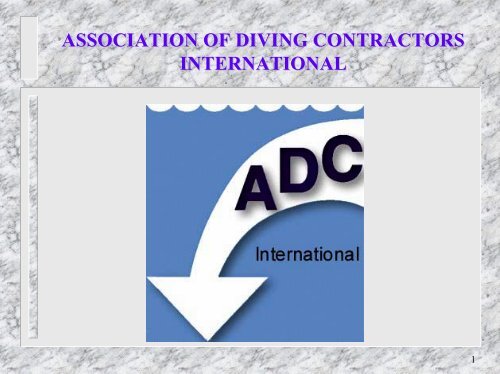
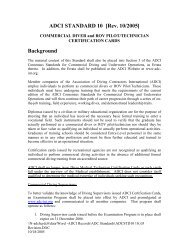
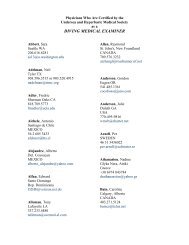
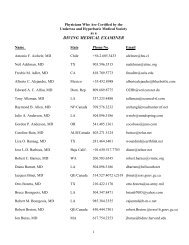
![SOLICITUD MEMBRESIA ASOCIADO [Rev 06/08] - Association of ...](https://img.yumpu.com/48291988/1/190x245/solicitud-membresia-asociado-rev-06-08-association-of-.jpg?quality=85)

